CHEVROLET CORVETTE 2010 6.G Owners Manual
Manufacturer: CHEVROLET, Model Year: 2010, Model line: CORVETTE, Model: CHEVROLET CORVETTE 2010 6.GPages: 472, PDF Size: 11.44 MB
Page 421 of 472
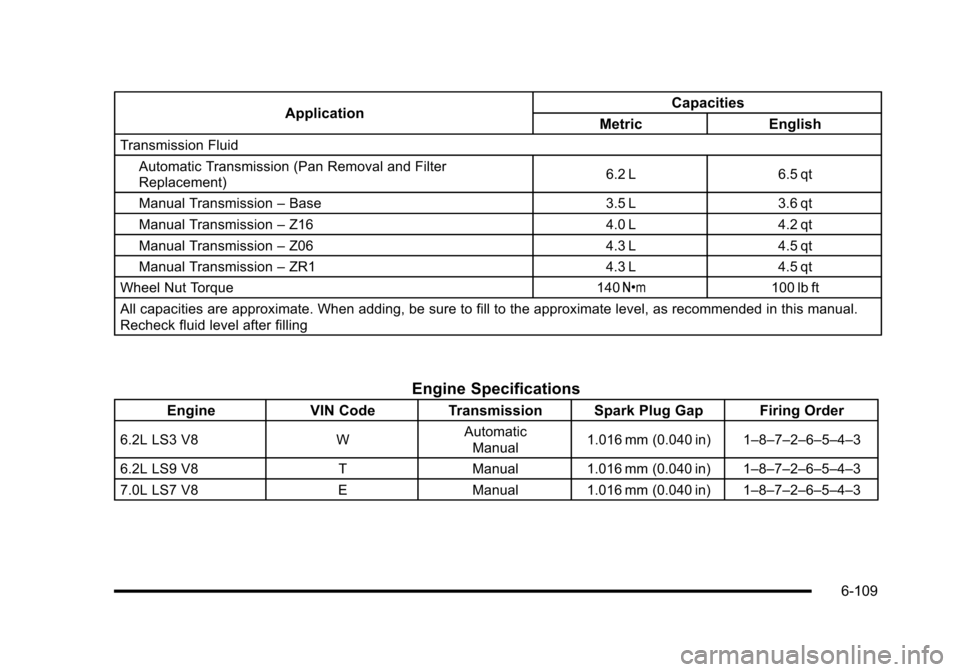
Application Capacities
Metric English
Transmission Fluid
Automatic Transmission (Pan Removal and Filter
Replacement) 6.2 L
6.5 qt
Manual Transmission âBase 3.5 L3.6 qt
Manual Transmission âZ16 4.0 L4.2 qt
Manual Transmission âZ06 4.3 L4.5 qt
Manual Transmission âZR1 4.3 L4.5 qt
Wheel Nut Torque 140 Y 100 lb ft
All capacities are approximate. When adding, be sure to fill to the approximate level, as recommended in this manual.
Recheck fluid level after filling
Engine Specifications
Engine VIN CodeTransmission Spark Plug Gap Firing Order
6.2L LS3 V8 W Automatic
Manual 1.016 mm (0.040 in) 1â8â7â2â6â5â4â3
6.2L LS9 V8 TManual1.016 mm (0.040 in) 1â8â7â2â6â5â4â3
7.0L LS7 V8 EManual1.016 mm (0.040 in) 1â8â7â2â6â5â4â3
6-109
Page 422 of 472
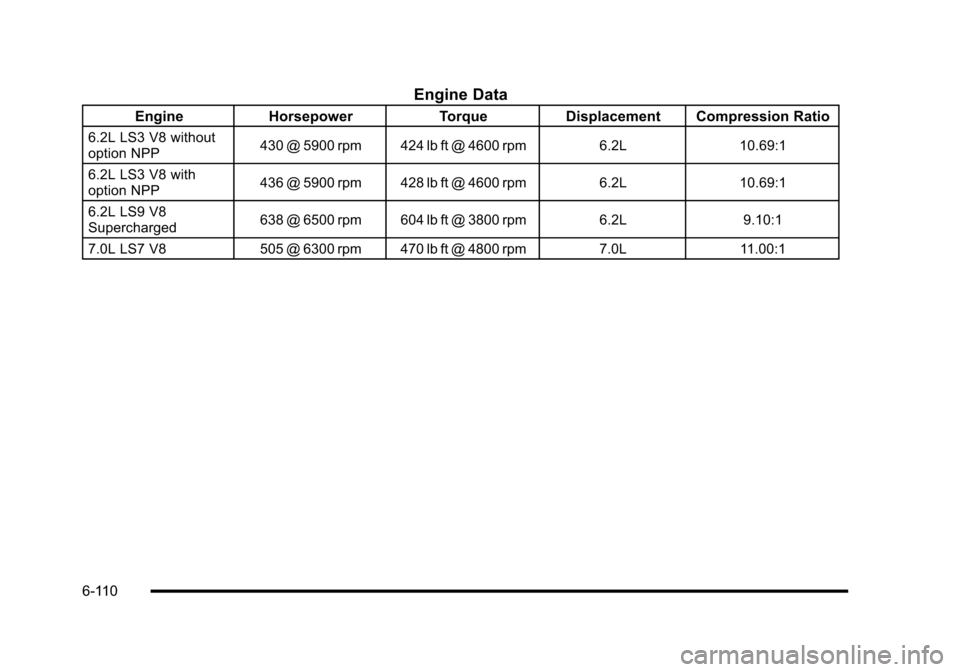
Engine Data
EngineHorsepower TorqueDisplacement Compression Ratio
6.2L LS3 V8 without
option NPP 430 @ 5900 rpm 424 lb ft @ 4600 rpm
6.2L10.69:1
6.2L LS3 V8 with
option NPP 436 @ 5900 rpm 428 lb ft @ 4600 rpm
6.2L10.69:1
6.2L LS9 V8
Supercharged 638 @ 6500 rpm 604 lb ft @ 3800 rpm
6.2L9.10:1
7.0L LS7 V8 505 @ 6300 rpm 470 lb ft @ 4800 rpm 7.0L11.00:1
6-110
Page 423 of 472
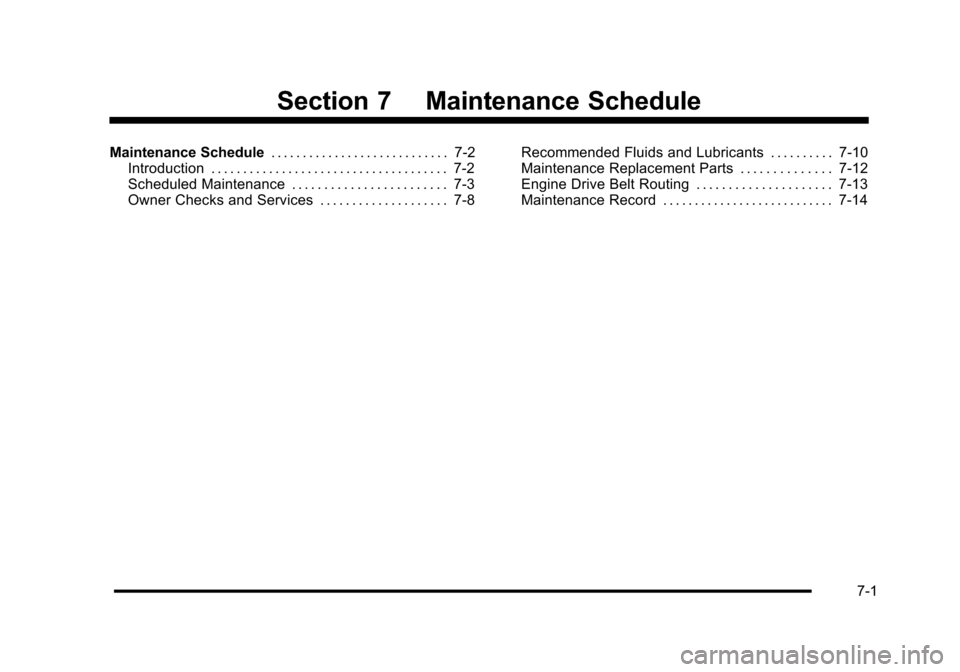
Section 7 Maintenance Schedule
Maintenance Schedule. . . . . . . . . . . . . . . . . . . . . . . . . . . . 7-2
Introduction . . . . . . . . . . . . . . . . . . . . . . . . . . . . . . . . . . . . . 7-2
Scheduled Maintenance . . . . . . . . . . . . . . . . . . . . . . . . 7-3
Owner Checks and Services . . . . . . . . . . . . . . . . . . . . 7-8 Recommended Fluids and Lubricants . . . . . . . . . . 7-10
Maintenance Replacement Parts . . . . . . . . . . . . . . 7-12
Engine Drive Belt Routing . . . . . . . . . . . . . . . . . . . . . 7-13
Maintenance Record . . . . . . . . . . . . . . . . . . . . . . . . . . . 7-14
7-1
Page 424 of 472
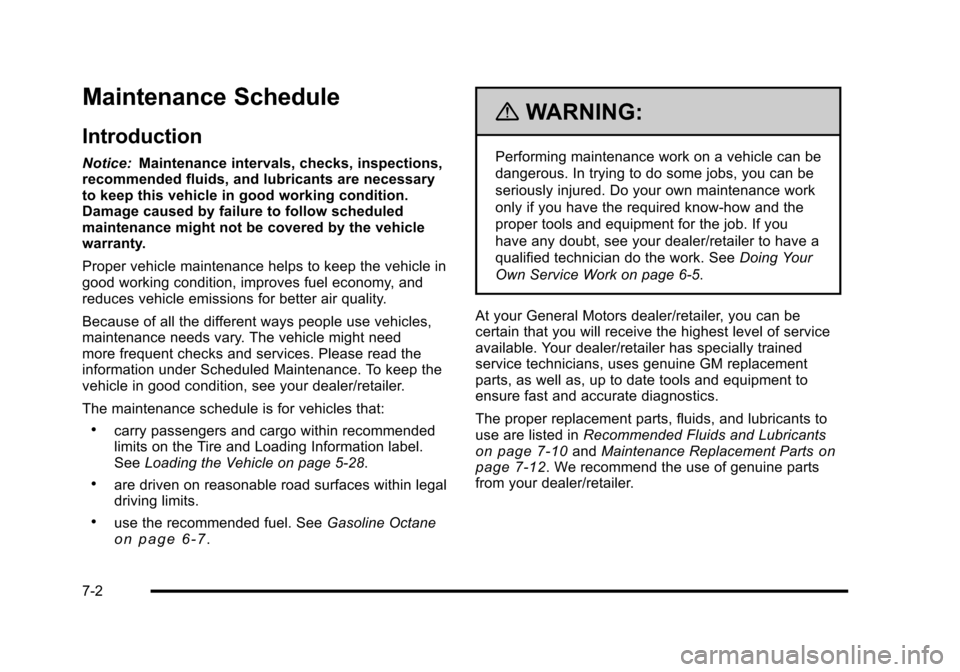
Maintenance Schedule
Introduction
Notice:Maintenance intervals, checks, inspections,
recommended fluids, and lubricants are necessary
to keep this vehicle in good working condition.
Damage caused by failure to follow scheduled
maintenance might not be covered by the vehicle
warranty.
Proper vehicle maintenance helps to keep the vehicle in
good working condition, improves fuel economy, and
reduces vehicle emissions for better air quality.
Because of all the different ways people use vehicles,
maintenance needs vary. The vehicle might need
more frequent checks and services. Please read the
information under Scheduled Maintenance. To keep the
vehicle in good condition, see your dealer/retailer.
The maintenance schedule is for vehicles that:
.carry passengers and cargo within recommended
limits on the Tire and Loading Information label.
See Loading the Vehicle on page 5â28.
.are driven on reasonable road surfaces within legal
driving limits.
.use the recommended fuel. See Gasoline Octaneon page 6â7.
{WARNING:
Performing maintenance work on a vehicle can be
dangerous. In trying to do some jobs, you can be
seriously injured. Do your own maintenance work
only if you have the required know-how and the
proper tools and equipment for the job. If you
have any doubt, see your dealer/retailer to have a
qualified technician do the work. See Doing Your
Own Service Work on page 6â5.
At your General Motors dealer/retailer, you can be
certain that you will receive the highest level of service
available. Your dealer/retailer has specially trained
service technicians, uses genuine GM replacement
parts, as well as, up to date tools and equipment to
ensure fast and accurate diagnostics.
The proper replacement parts, fluids, and lubricants to
use are listed in Recommended Fluids and Lubricants
on page 7â10andMaintenance Replacement Partson
page 7â12. We recommend the use of genuine parts
from your dealer/retailer.
7-2
Page 425 of 472
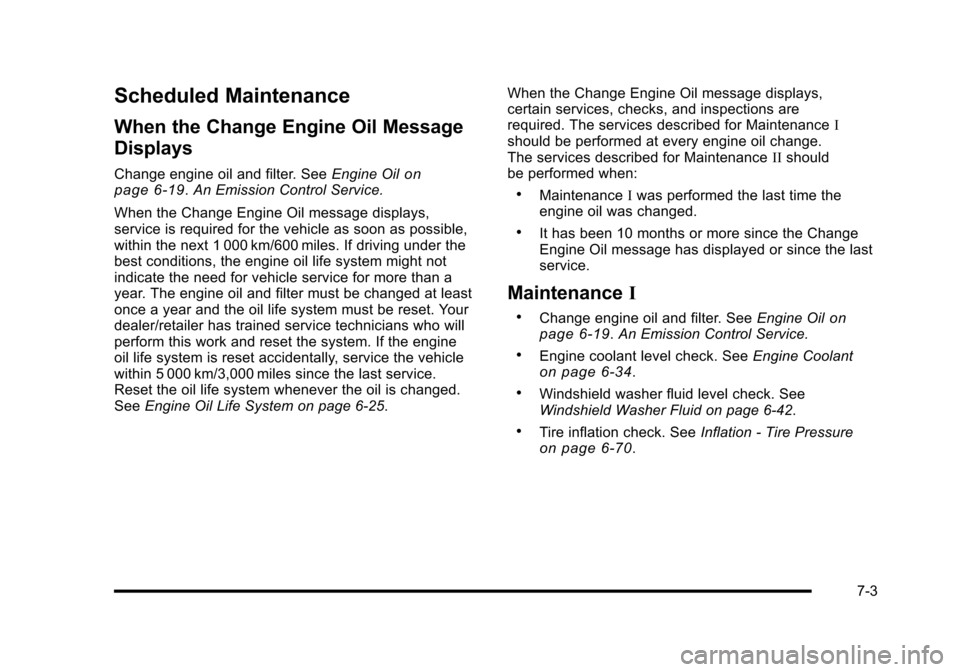
Scheduled Maintenance
When the Change Engine Oil Message
Displays
Change engine oil and filter. See Engine Oilon
page 6â19. An Emission Control Service.
When the Change Engine Oil message displays,
service is required for the vehicle as soon as possible,
within the next 1 000 km/600 miles. If driving under the
best conditions, the engine oil life system might not
indicate the need for vehicle service for more than a
year. The engine oil and filter must be changed at least
once a year and the oil life system must be reset. Your
dealer/retailer has trained service technicians who will
perform this work and reset the system. If the engine
oil life system is reset accidentally, service the vehicle
within 5 000 km/3,000 miles since the last service.
Reset the oil life system whenever the oil is changed.
See Engine Oil Life System on page 6â25. When the Change Engine Oil message displays,
certain services, checks, and inspections are
required. The services described for Maintenance
I
should be performed at every engine oil change.
The services described for Maintenance IIshould
be performed when:.Maintenance Iwas performed the last time the
engine oil was changed.
.It has been 10 months or more since the Change
Engine Oil message has displayed or since the last
service.
Maintenance I
.Change engine oil and filter. See Engine Oilon
page 6â19. An Emission Control Service.
.Engine coolant level check. See Engine Coolanton page 6â34.
.Windshield washer fluid level check. See
Windshield Washer Fluid on page 6â42.
.Tire inflation check. See Inflation - Tire Pressureon page 6â70.
7-3
Page 426 of 472
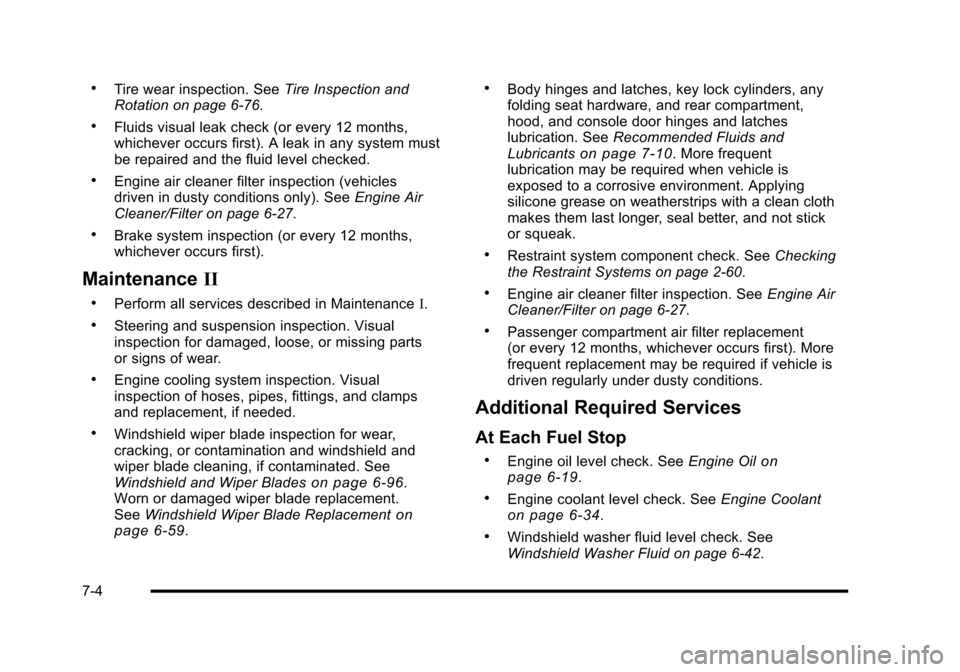
.Tire wear inspection. SeeTire Inspection and
Rotation on page 6â76.
.Fluids visual leak check (or every 12 months,
whichever occurs first). A leak in any system must
be repaired and the fluid level checked.
.Engine air cleaner filter inspection (vehicles
driven in dusty conditions only). See Engine Air
Cleaner/Filter on page 6â27.
.Brake system inspection (or every 12 months,
whichever occurs first).
Maintenance II
.Perform all services described in Maintenance I.
.Steering and suspension inspection. Visual
inspection for damaged, loose, or missing parts
or signs of wear.
.Engine cooling system inspection. Visual
inspection of hoses, pipes, fittings, and clamps
and replacement, if needed.
.Windshield wiper blade inspection for wear,
cracking, or contamination and windshield and
wiper blade cleaning, if contaminated. See
Windshield and Wiper Blades
on page 6â96.
Worn or damaged wiper blade replacement.
See Windshield Wiper Blade Replacement
on
page 6â59.
.Body hinges and latches, key lock cylinders, any
folding seat hardware, and rear compartment,
hood, and console door hinges and latches
lubrication. See Recommended Fluids and
Lubricants
on page 7â10. More frequent
lubrication may be required when vehicle is
exposed to a corrosive environment. Applying
silicone grease on weatherstrips with a clean cloth
makes them last longer, seal better, and not stick
or squeak.
.Restraint system component check. See Checking
the Restraint Systems on page 2â60.
.Engine air cleaner filter inspection. See Engine Air
Cleaner/Filter on page 6â27.
.Passenger compartment air filter replacement
(or every 12 months, whichever occurs first). More
frequent replacement may be required if vehicle is
driven regularly under dusty conditions.
Additional Required Services
At Each Fuel Stop
.Engine oil level check. See Engine Oilon
page 6â19.
.Engine coolant level check. See Engine Coolanton page 6â34.
.Windshield washer fluid level check. See
Windshield Washer Fluid on page 6â42.
7-4
Page 427 of 472
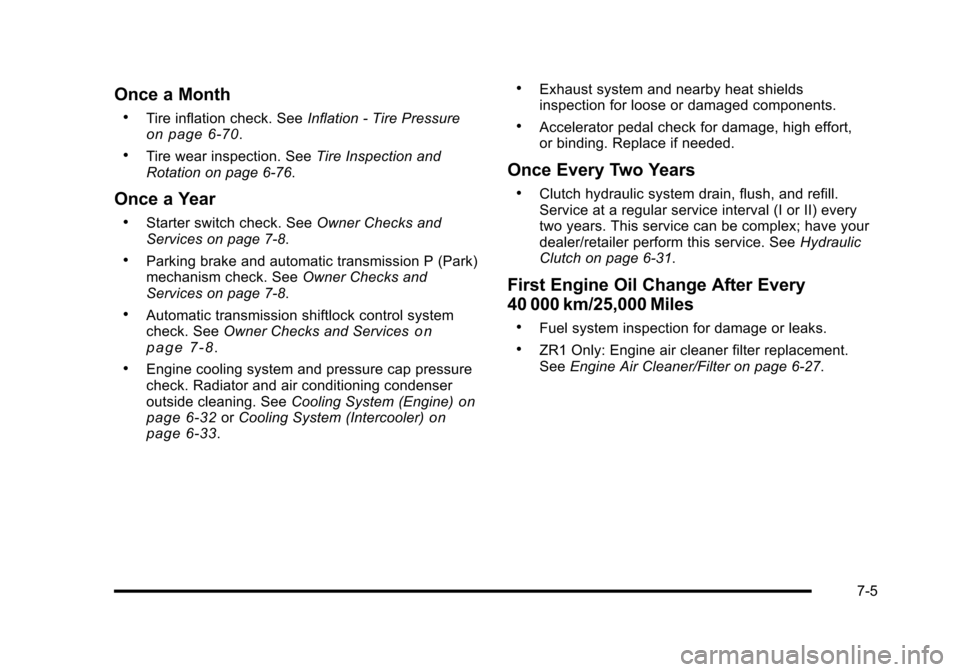
Once a Month
.Tire inflation check. SeeInflation - Tire Pressureon page 6â70.
.Tire wear inspection. See Tire Inspection and
Rotation on page 6â76.
Once a Year
.Starter switch check. See Owner Checks and
Services on page 7â8.
.Parking brake and automatic transmission P (Park)
mechanism check. See Owner Checks and
Services on page 7â8.
.Automatic transmission shiftlock control system
check. See Owner Checks and Serviceson
page 7â8.
.Engine cooling system and pressure cap pressure
check. Radiator and air conditioning condenser
outside cleaning. See Cooling System (Engine)
on
page 6â32or Cooling System (Intercooler)on
page 6â33.
.Exhaust system and nearby heat shields
inspection for loose or damaged components.
.Accelerator pedal check for damage, high effort,
or binding. Replace if needed.
Once Every Two Years
.Clutch hydraulic system drain, flush, and refill.
Service at a regular service interval (I or II) every
two years. This service can be complex; have your
dealer/retailer perform this service. See Hydraulic
Clutch on page 6â31.
First Engine Oil Change After Every
40 000 km/25,000 Miles
.Fuel system inspection for damage or leaks.
.ZR1 Only: Engine air cleaner filter replacement.
See Engine Air Cleaner/Filter on page 6â27.
7-5
Page 428 of 472
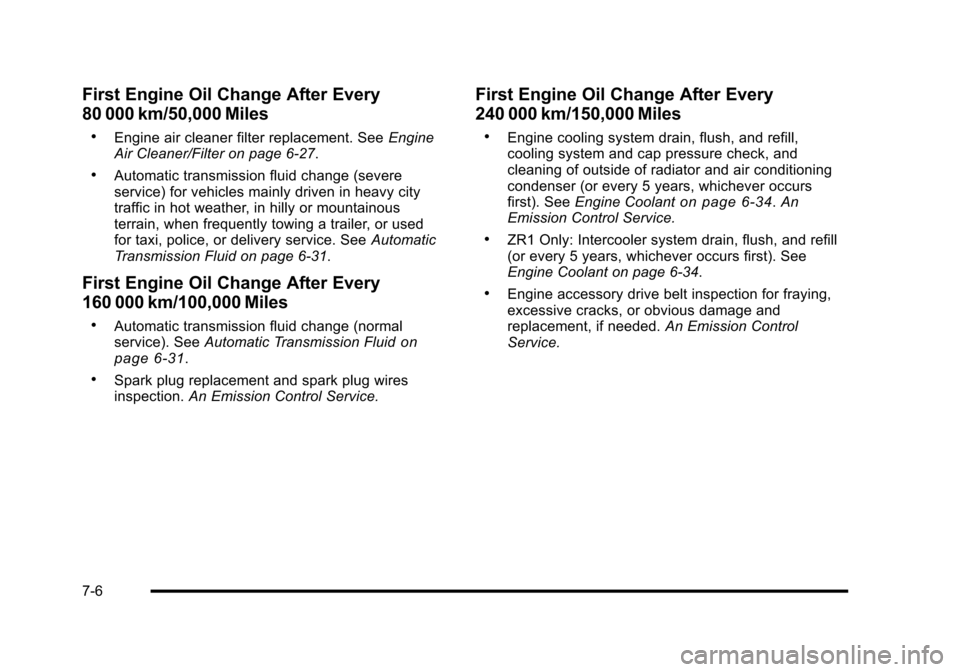
First Engine Oil Change After Every
80 000 km/50,000 Miles
.Engine air cleaner filter replacement. See Engine
Air Cleaner/Filter on page 6â27.
.Automatic transmission fluid change (severe
service) for vehicles mainly driven in heavy city
traffic in hot weather, in hilly or mountainous
terrain, when frequently towing a trailer, or used
for taxi, police, or delivery service. See Automatic
Transmission Fluid on page 6â31.
First Engine Oil Change After Every
160 000 km/100,000 Miles
.Automatic transmission fluid change (normal
service). See Automatic Transmission Fluidon
page 6â31.
.Spark plug replacement and spark plug wires
inspection. An Emission Control Service.
First Engine Oil Change After Every
240 000 km/150,000 Miles
.Engine cooling system drain, flush, and refill,
cooling system and cap pressure check, and
cleaning of outside of radiator and air conditioning
condenser (or every 5 years, whichever occurs
first). See Engine Coolant
on page 6â34.An
Emission Control Service.
.ZR1 Only: Intercooler system drain, flush, and refill
(or every 5 years, whichever occurs first). See
Engine Coolant on page 6â34.
.Engine accessory drive belt inspection for fraying,
excessive cracks, or obvious damage and
replacement, if needed. An Emission Control
Service.
7-6
Page 429 of 472
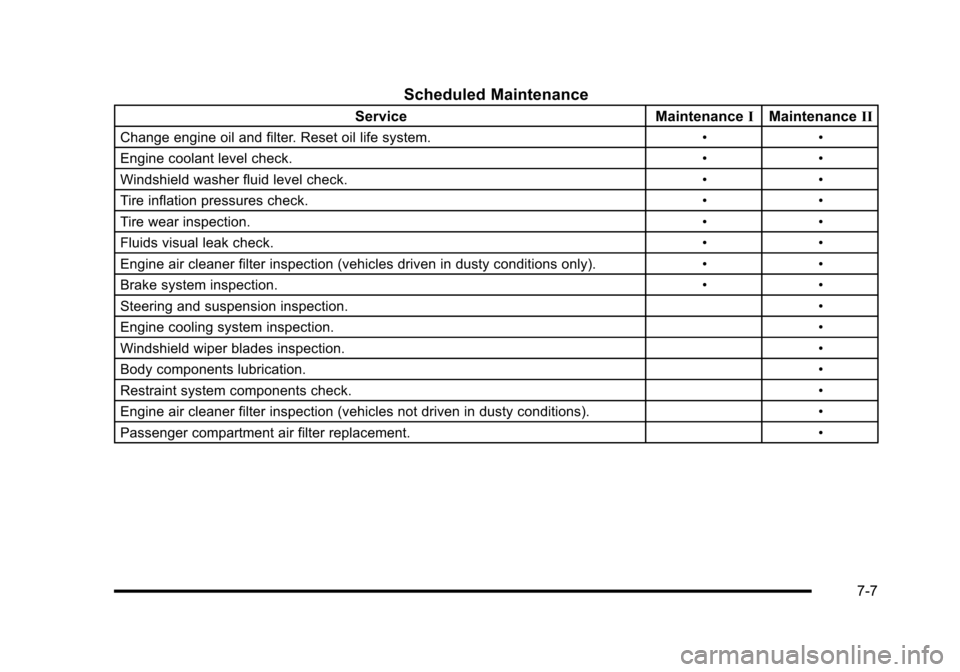
Scheduled Maintenance
ServiceMaintenanceIMaintenance II
Change engine oil and filter. Reset oil life system. â¢â¢
Engine coolant level check. â¢â¢
Windshield washer fluid level check. â¢â¢
Tire inflation pressures check. â¢â¢
Tire wear inspection. â¢â¢
Fluids visual leak check. â¢â¢
Engine air cleaner filter inspection (vehicles driven in dusty conditions only). â¢â¢
Brake system inspection. â¢â¢
Steering and suspension inspection. â¢
Engine cooling system inspection. â¢
Windshield wiper blades inspection. â¢
Body components lubrication. â¢
Restraint system components check. â¢
Engine air cleaner filter inspection (vehicles not driven in dusty conditions). â¢
Passenger compartment air filter replacement. â¢
7-7
Page 430 of 472
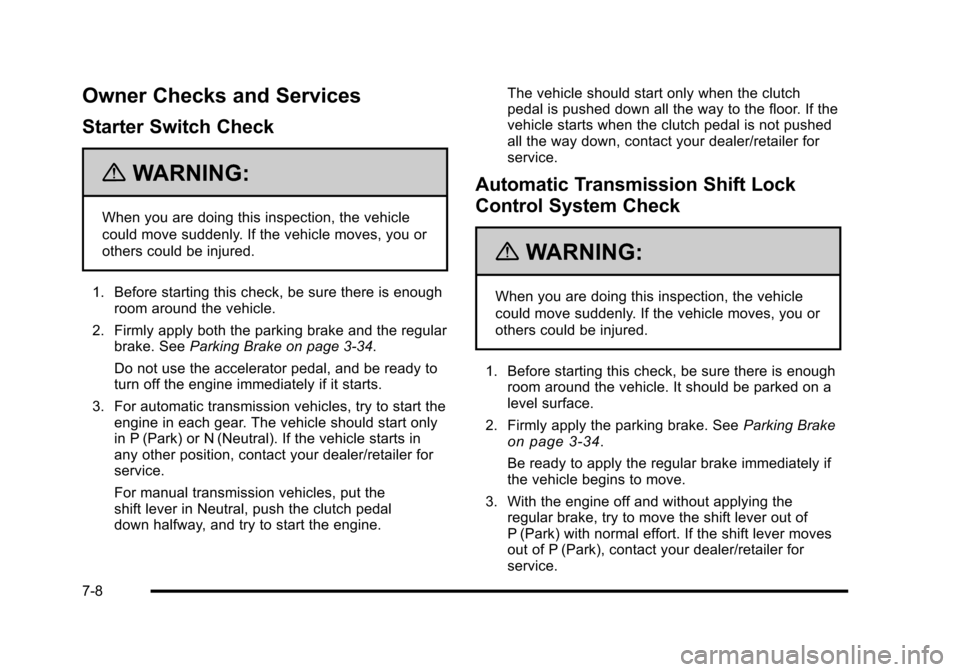
Owner Checks and Services
Starter Switch Check
{WARNING:
When you are doing this inspection, the vehicle
could move suddenly. If the vehicle moves, you or
others could be injured.
1. Before starting this check, be sure there is enough room around the vehicle.
2. Firmly apply both the parking brake and the regular brake. See Parking Brake on page 3â34.
Do not use the accelerator pedal, and be ready to
turn off the engine immediately if it starts.
3. For automatic transmission vehicles, try to start the engine in each gear. The vehicle should start only
in P (Park) or N (Neutral). If the vehicle starts in
any other position, contact your dealer/retailer for
service.
For manual transmission vehicles, put the
shift lever in Neutral, push the clutch pedal
down halfway, and try to start the engine. The vehicle should start only when the clutch
pedal is pushed down all the way to the floor. If the
vehicle starts when the clutch pedal is not pushed
all the way down, contact your dealer/retailer for
service.
Automatic Transmission Shift Lock
Control System Check
{WARNING:
When you are doing this inspection, the vehicle
could move suddenly. If the vehicle moves, you or
others could be injured.
1. Before starting this check, be sure there is enough room around the vehicle. It should be parked on a
level surface.
2. Firmly apply the parking brake. See Parking Brake
on page 3â34.
Be ready to apply the regular brake immediately if
the vehicle begins to move.
3. With the engine off and without applying the regular brake, try to move the shift lever out of
P (Park) with normal effort. If the shift lever moves
out of P (Park), contact your dealer/retailer for
service.
7-8